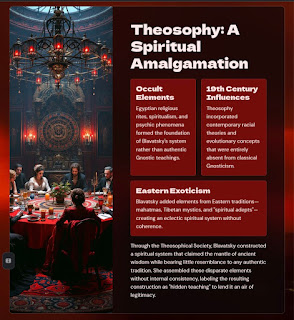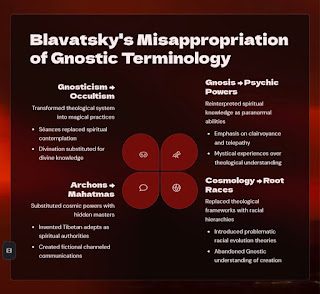**Esoteric Confusion: How Helena Blavatsky Corrupted Classical Gnostic Doctrine**
*Article by Alexander Maistrovoy*
Helena Petrovna Blavatsky is frequently mentioned in modern literature as a supposed follower of Gnostic teachings. But how fair is this association?
It is evident that Blavatsky was familiar with Gnosticism. She knew its language, understood its symbolic framework, and even expressed admiration for the Gnostics and their teachings. In her writings, she asked provocatively, *“Were the Gnostics so wrong, after this, in affirming that this our visible world, and especially the Earth, had been created by lower angels, the inferior Elohim, of which, as they taught, the God of the Israelites?”* She declared that *“The Gnostics were right, then, in calling the Jewish god ‘an angel of matter,’ or he who breathed (conscious) life into Adam, and he whose planet was Saturn.”*
Blavatsky praised the intellectual and cultural qualities of early Gnostic thinkers. *“For these Gnostics—the inspirers of primitive Christianity—were ‘the most cultured, the most learned and most wealthy of the Christian name,’ as Gibbon has it,”* she wrote approvingly. She admired the fact that they did not accept the literal meanings of sacred texts, but rather sought deeper symbolic truths.
However, this recognition and praise conceal a deeper distortion. Blavatsky's engagement with Gnosticism did not preserve its authentic tradition—it obscured and warped it.
Blavatsky was a spiritual adventurer, enamored with mysticism and the allure of the hidden. Her explorations led her to found the Theosophical Society and to develop the doctrine of Theosophy. This system was not grounded in historical Gnostic belief, but was a confused amalgamation of Egyptian religious rites, occult speculation, spiritualism, and psychic phenomena. To this she added fashionable 19th-century racial theories, evolutionary concepts, and exotic Eastern elements—mahatmas, Tibetan mystics, and "spiritual adepts." This entire construction, assembled without coherence or fidelity to any one tradition, she labeled “hidden teaching.”
Blavatsky was captivated by the idea of *gnosis*, or knowledge, and made it the cornerstone of her theosophical architecture. But in doing so, she stripped the term of its theological and philosophical significance. In the hands of the original Gnostics of the Eastern Mediterranean and Mesopotamia, *gnosis* was a precise and often sober reflection on the human condition, creation, and the struggle between knowledge and ignorance. It was firmly embedded in the context of early Christianity, Jewish thought, and Greco-Roman philosophy.
Blavatsky’s interpretation of *gnosis* was something else entirely. By blending it with occultism and fantastical ideas about spirits, astral bodies, and hidden masters, she helped create the modern stereotype of Gnosticism as a mystical, irrational, and occult movement. In reality, the classical Gnostics were far removed from the esoteric cultism she promoted.
Through her influence, Gnosticism became associated with the broad, undefined spirituality of the New Age movement. She is, in many ways, the “godmother” of that movement. In this role, she transformed the clear theological and metaphysical questions posed by the Gnostics into a chaotic spiritual stew. True Gnosticism was drowned in this extravagant brew.
In the end, Blavatsky was a Theosophist, not a Gnostic. She was not even a Christian. If asked to choose a religion, she would have leaned toward Hinduism or Buddhism, traditions she held in far higher regard than Christianity. And since Gnosticism belongs historically and conceptually within the early Christian world, it could never truly fit into Blavatsky’s framework.
Her legacy is not one of preserving Gnosticism but of corrupting and confusing it. Because of her, the word *gnosis* no longer evokes the rigorous spiritual insight of ancient seekers, but instead calls to mind the vague mysticism and esotericism of modern pseudo-religions. The damage she did to the integrity of classical Gnostic doctrine continues to this day.

















No comments:
Post a Comment